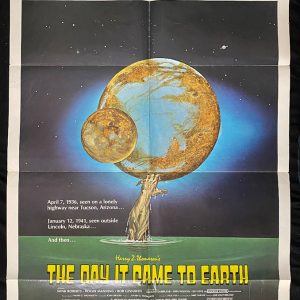calsfoundation@cals.org
The Day It Came to Earth
The Day It Came to Earth is a 1977 horror/science fiction feature film directed by Arkansan Harry Thomason. It was filmed in and around Little Rock (Pulaski County). Running at eighty-eight minutes and rated PG (for violence), the movie features a number of local Arkansas actors, such as Little Rock advertising executive Robert (Bob) Ginnaven (1937–2008) in addition to comedian George Gobel near the end of his career and actress Rita Wilson at the beginning of hers.
The story, written by Paul Fisk, begins with a glowing meteorite falling into a secluded pond. Gangsters have dumped the body of one of their victims into the pond. The water takes on rejuvenating powers from the meteorite, causing the dead body to come back to life as a monster seeking revenge. Meanwhile, local college students use the pond for a swimming hole one evening, thereby crossing paths with the monster.
The students were portrayed by Wink Roberts, Roger Manning, Delight De Bruine, and Rita Wilson (as Debbie). Prior to her appearance in The Day It Came to Earth, Wilson had small and/or uncredited television roles on The Brady Bunch, Movin’ On, and Lou Grant. In 1978 and 1979, she appeared on TV’s Flying High (also playing a character named Debbie) and Hawaii Five-O. In 1981, she appeared on TV’s Bosom Buddies, where she met her future husband, actor Tom Hanks.
In The Day It Came to Earth, the students see the meteorite fall into the pond and find some fragments that they take to the local university to win favor with Professor Bartholomew, played by George Gobel. From 1954 to 1960, Gobel starred in The George Gobel Show, winning a 1955 Emmy award for “Most Outstanding New Personality” (beating Walt Disney). Prior to The Day It Came to Earth, Gobel was appearing on TV’s Hollywood Squares. Afterward, he was featured on television’s Harper Valley P.T.A. and The Love Boat in 1981. In The Day It Came to Earth, Gobel’s character’s professorial examination of the meteorite fragments leads to the realization that the meteorite is the source of energy that has re-animated the corpse, dubbed a “Geophysical Gaseous Goon” or “Geegagoo” for short.
After a revenge killing of the gangsters, the creature returns to the lake, occasionally rising to collect pieces of the meteorite. The movie ends with a shrug by the police lieutenant. In its review summary, the New York Times called the movie a “campy little sci-fi oddity,” although it goes on to deride the film for “unimaginative monster mayhem, turgid pacing, and pathetic attempts at humor.”
Prior to producing The Day It Came to Earth in 1977, Harry Thomason had filmed several other Arkansas-based features: Encounter with the Unknown (1973), The Great Lester Boggs (1974), and So Sad about Gloria (1975). In 1979, he created one more, Revenge of Bigfoot, before going on to successful TV series such as Designing Women (1986–1993) and Evening Shade (1990–1994), both with their own Arkansas connections.
Upon its release, The Day It Came to Earth enjoyed a modest success at drive-ins. It was distributed in its theatrical release by Howco International Pictures and later became available on VHS/DVD. It was featured via syndicated television on Elvira’s Movie Macabre in 1982 and Svengoolie in 2005.
For additional information:
“The Day It Came to Earth.” Internet Movie Database. http://www.imdb.com/title/tt0079030/ (accessed October 1, 2020).
Nancy Hendricks
Garland County Historical Society






Comments
No comments on this entry yet.